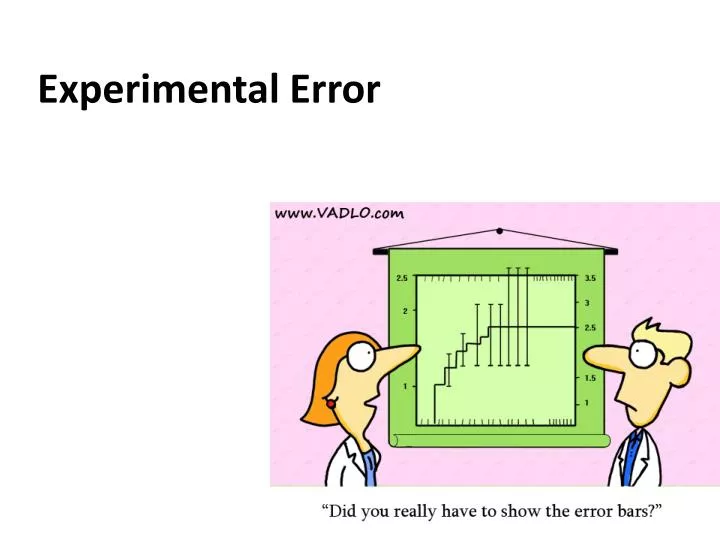Determining experimental error is a quintessential aspect of scientific inquiry, underpinning the robustness and reliability of empirical findings. In this article, we will delve into the various dimensions of experimental error, exploring the nuances that affect measurements and the methodologies employed to discern and quantify these errors. An understanding of experimental error not only enriches one’s comprehension of the scientific method but also deepens the fascination with the underlying processes that govern the natural world.
The first consideration in determining experimental error is the distinction between systematic and random errors. Systematic errors arise from consistent and repeatable factors that introduce bias into measurements, often stemming from calibration issues, environmental conditions, or inherent biases in measurement techniques. For instance, if a scale is improperly zeroed, every measurement taken will be offset by a fixed amount, skewing the results in one direction. By contrast, random errors are intrinsic variations that occur due to unpredictable fluctuations in measurements. These can be caused by factors such as variations in environmental temperature, minor fluctuations in instrument sensitivity, or human judgment errors during observation. A rigorous approach to identifying and categorizing these errors is imperative for refining measurement accuracy.
Next, one must consider the propagation of errors, an essential concept in experimental physics. When multiple measurements are involved, the errors associated with each individual measurement can propagate through complex calculations, magnifying the overall uncertainty. The law of propagation of uncertainty provides a mathematical framework for quantifying how uncertainties in individual measurements contribute to the total error in a calculated result. Coupling this with appropriate statistical methods allows researchers to estimate the degree of confidence in their findings, fostering a clearer understanding of the degree of reliability one can attribute to their experimental results.
To assess and quantify experimental error, researchers employ a variety of methods. The most fundamental technique involves taking repeated measurements. By gathering a sufficient sample size, one can compute the mean of the measurements, thereby reducing the impact of random errors. The standard deviation serves as a critical indicator in this context, providing a measure of the dispersion of the data points around the mean. A smaller standard deviation signals increased precision in the measurement process, while a larger standard deviation implies greater variability and uncertainty.
Moreover, the assessment of systematic error requires different tactics. Calibration against known standards or reference materials is fundamental. By comparing experimental results to established values, one can identify potential biases in the measurements. Such calibration must be conducted regularly, ensuring that instruments remain accurate over time, thereby minimizing systematic deviations. Additionally, blind experiments—where the experimenter is unaware of critical variables during data collection—can mitigate the influence of subjective bias, enhancing the integrity of the data.
Another pivotal aspect of determining experimental error is the identification of outliers. These anomalous data points can significantly skew results and lead to inaccurate conclusions. Employing statistical tools such as the Grubb’s test or the Dixon’s Q test assists in objectively identifying these outliers. Once recognized, researchers must make a judicious decision: whether to exclude these points based on their influence on the overall results or investigate further to ascertain the reasons behind their deviation.
Furthermore, the understanding of error in experimental design is paramount. When designing experiments, one must contemplate the variables that may introduce error and strategize to mitigate their impact. Randomized controls, replication, and blinding are methodologies that can bolster the reliability of experimental outcomes. By ensuring that every factor is accounted for, one can approach the problem of error with a well-rounded awareness, reducing potential discrepancies in the results.
Another avenue through which experimental error can be explored is through error analysis techniques such as Monte Carlo simulations. This computational method employs random sampling to understand the behavior of systems under uncertainty. By running numerous simulations that incorporate the inherent variability in measurements, researchers can generate a distribution of possible outcomes, illuminating the degree of uncertainty afflicting their results. This approach not only enhances the understanding of error but also replicates real-world complexities in experimental models, fostering a more comprehensive understanding of the interactions at play.
In the context of reporting experimental findings, it is vital to communicate uncertainties transparently. Expressing results with associated error margins—such as confidence intervals or percent errors—allows for a nuanced appreciation of the data. These statistical expressions become vital when making comparisons across studies, interpreting results within the broader scientific dialogue, and aiding in the validation or refutation of existing theories.
Ultimately, the determination of experimental error is an intricate interplay of scientific rigor and methodological precision. By navigating the labyrinth of systematic and random errors, employing comprehensive statistical analyses, and adopting systematic uncertainty management techniques, researchers can approach the ideal of accuracy in measurements. Greater insight into these practices not only fortifies the findings of individual studies but also contributes to the collective knowledge of humanity, echoing the nuanced ways in which we unravel the mysteries of the universe.










